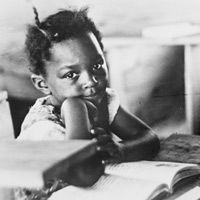 |

許多黑人兒童就讀的學校、都不如白人兒童的學校來得好。 Many black children attended schools that were not as good as those for white students.

|
 |
|
 |
從Briggs案 到 Brown案
在1940年代後期與1950年代早期,馬歇爾擔任「全國有色人種協進會」(NAACP)的主要法官,馬歇爾與「全國有色人種協進會」都希望能改變現行的法律,因為現行的法律認為目前白種人與黑種人就讀不同學校、只要是平等的就沒有什麼問題,而事實上,隔離的作法幾乎不可能達到公平的目標。
在1951年南卡羅萊納州的Clarendon郡,黑人兒童要花上三倍的費用、才能就讀和白人兒童一樣的學校,黑人兒童的父母必須提出訴訟案、才能為小孩爭取念到好學校的機會,這個案件成為後來著名的Briggs v. Elliott案,由馬歇爾率領「全國有色人種協進會」(NAACP)其他律師一起完成。
In the late 1940s and early 1950s, Marshall was the chief staff lawyer for the National Association for the Advancement of Colored People (NAACP). Marshall and the NAACP were trying to change the current law, which said it was OK to have separate schools for blacks and whites as long as they were equal. In reality, separate almost never meant equal.
In 1951, Clarendon County, South Carolina, spent more than three times as much on each white child's education as it did on each black child. A black Clarendon County principal asked black parents to file a lawsuit to demand better schools for their children. The case became known as Briggs v. Elliott, and Marshall led the team of NAACP lawyers.

 2 / 4 頁
2 / 4 頁

|





